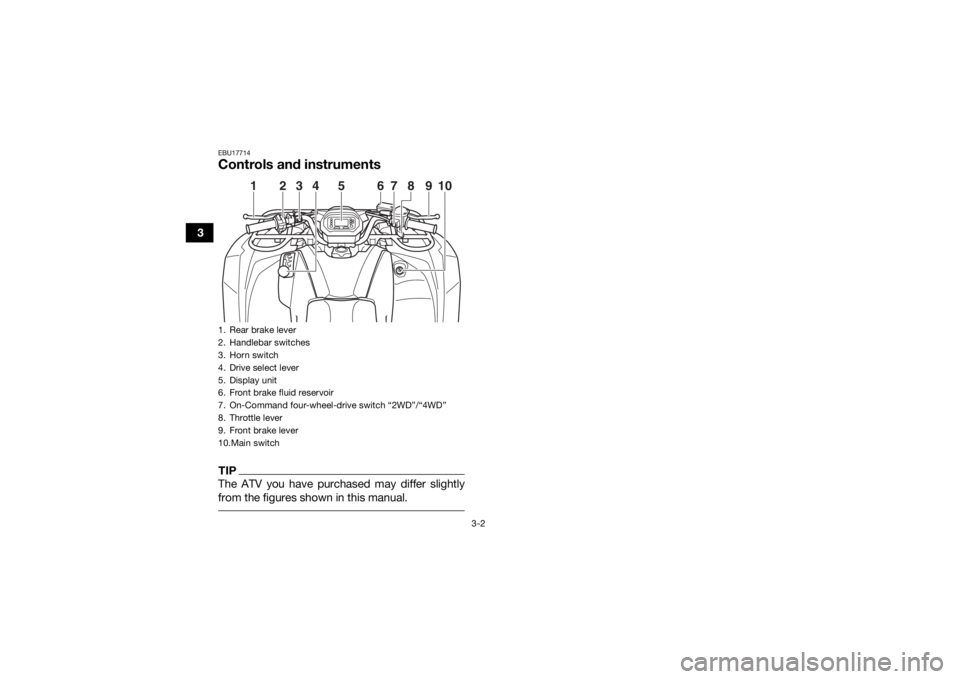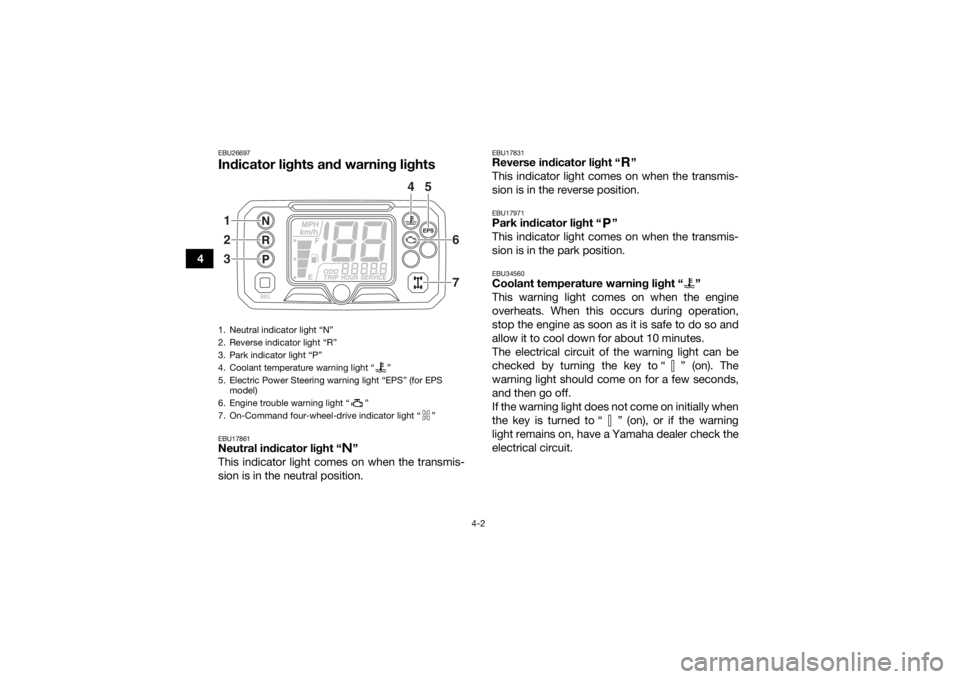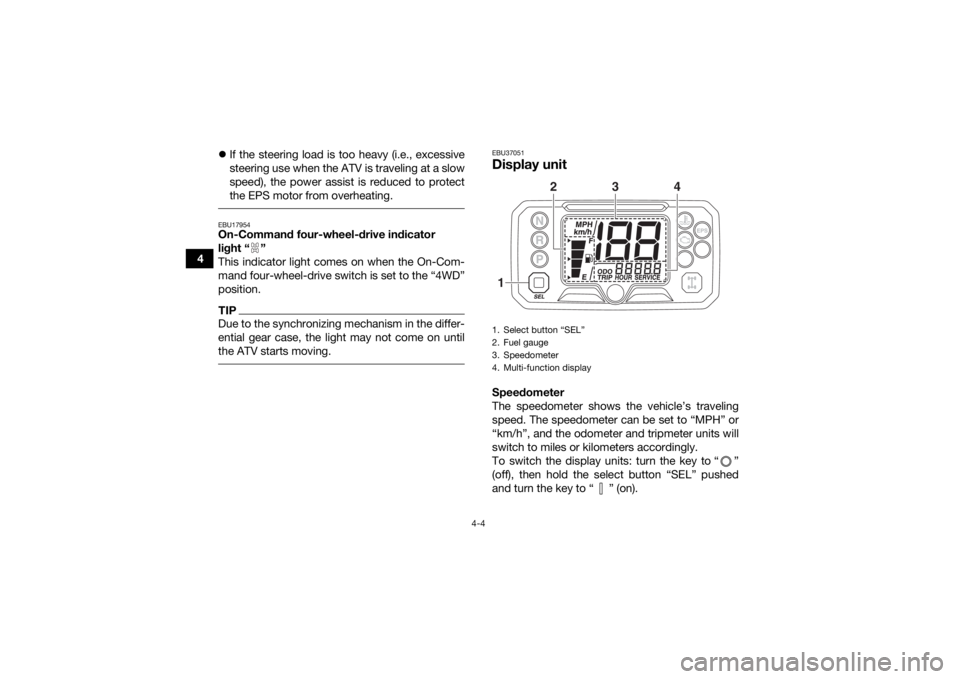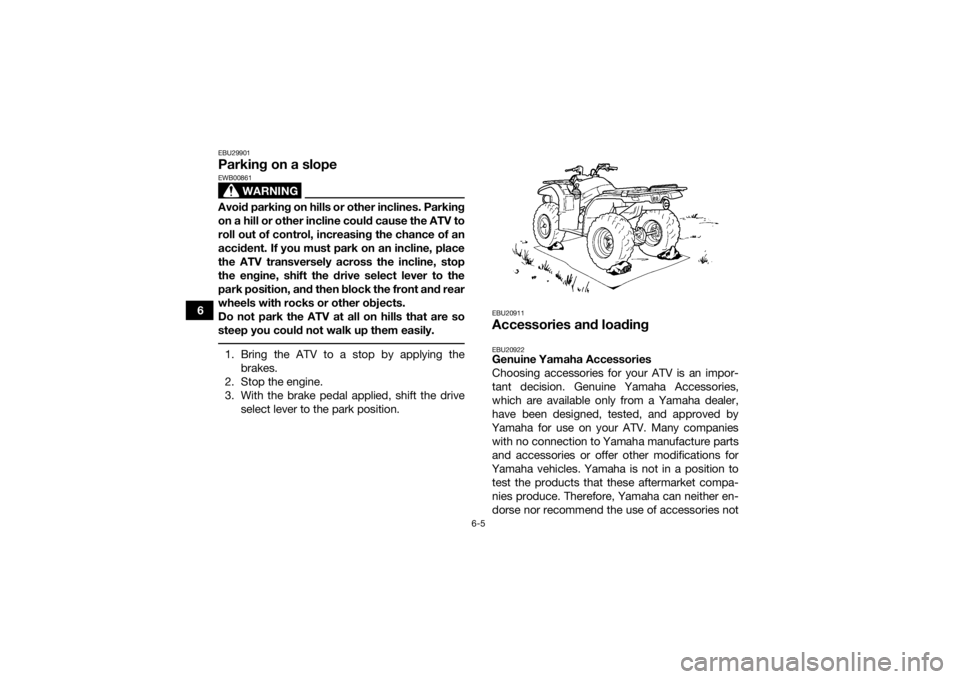wheel YAMAHA KODIAK 450 2018 Owners Manual
[x] Cancel search | Manufacturer: YAMAHA, Model Year: 2018, Model line: KODIAK 450, Model: YAMAHA KODIAK 450 2018Pages: 162, PDF Size: 4.86 MB
Page 11 of 162

Checking and lubricating the front and rear brake levers ..................................... 8-47
Checking and lubricating the brake pedal ....................................................... 8-48
Checking the wheel hub bearings............. 8-48
Lubricating the drive shaft universal joint ......................................................... 8-48
Checking the stabilizer bushes ................. 8-49
Lubricating the rear knuckle pivots ........... 8-49
Lubricating the steering shaft ................... 8-50
Battery....................................................... 8-51
Replacing a fuse ....................................... 8-54
Replacing a headlight bulb ....................... 8-57
Adjusting a headlight beam ...................... 8-60
Replacing the tail/brake light bulb ............ 8-61
Removing a wheel ..................................... 8-61
Installing a wheel....................................... 8-62
Troubleshooting ........................................ 8-63
Troubleshooting charts ............................. 8-64
CLEANING AND STORAGE ........................... 9-1 Cleaning ...................................................... 9-1
Storage........................................................ 9-2 SPECIFICATIONS ........................................ 10-1
CONSUMER INFORMATION....................... 11-1
Identification numbers .............................. 11-1
INDEX .......................................................... 12-1
UBB560E0.book Page 3 Tuesday, May 9, 2017 5:31 PM
Page 24 of 162

2-2
2
Never operate at speeds too fast for your skills
or the riding conditions. Always go at a speed
that is proper for the terrain, visibility, operating
conditions, and your experience.
Never attempt wheelies, jumps, or other stunts.
Always inspect your ATV each time you use it to
make sure it is in safe operating condition. Al-
ways follow the inspection and maintenance
procedures and schedules described in this
manual.
Always keep both hands on the handlebars and
both feet on the footboards of the ATV during
operation.
Always go slowly and be extra careful when op-
erating on unfamiliar terrain. Always be alert to
changing terrain conditions when operating the
ATV.
Never operate on excessively rough, slippery or
loose terrain until you have learned and prac-
ticed the skills necessary to control the ATV on
such terrain. Always be especially cautious on
these kinds of terrain.
Always follow proper procedures for turning as
described in this manual. Practice turning at low
speeds before attempting to turn at faster
speeds and never turn at excessive speeds.
Never operate the ATV on hills too steep for the
ATV or for your abilities. Practice on smaller hills
before attempting larger hills.
Always follow proper procedures for climbing
hills as described in this manual. Check the ter-
rain carefully before you start up any hill. Never
climb hills with excessively slippery or loose
surfaces. Shift your weight forward. Never open
the throttle suddenly. Never go over the top of a
hill at high speed.
Always follow proper procedures for going
down hills and for braking on hills as described
in this manual. Check the terrain carefully before
you start down any hill. Shift your weight back-
ward. Never go down a hill at high speed. Avoid
going down a hill at an angle that would cause
the vehicle to lean sharply to one side. Go
straight down the hill where possible.
Always follow proper procedures for crossing
the side of a hill as described in this manual.
Avoid hills with excessively slippery or loose
surfaces. Shift your weight to the uphill side of
the ATV. Never attempt to turn the ATV around
on any hill until you have mastered the turning
UBB560E0.book Page 2 Friday, March 10, 2017 10:20 AM
Page 27 of 162

2-5
2
ungrounded or broken wiring. Visually check
for broken wiring and leaking fuel. Leaking
fuel can be confirmed by the odor of gasoline.
4. Once immediate safety hazards are con- firmed not to exist, you may remove your hel-
met to more closely inspect your vehicle.
Check for external signs of wear, broken
parts, fluid leaks, cracks in the frame, sus-
pension damage, wheel damage, and so on.
Fuel, oil, and coolant usually give off a notice-
able odor.
5. If your vehicle will not restart or if it is unsafe to ride, then turn off all vehicle systems (en-
gine stop switch, main switch, and fuel cock),
and then signal or go for help.
Aftermarket Parts, Accessories, and Modifica-
tions
While you may find aftermarket products similar in
design and quality to genuine Yamaha accesso-
ries, recognize that some aftermarket accessories
or modifications are not suitable because of po-
tential safety hazards to you or others. Installing
aftermarket products or having other modifica-
tions performed to your vehicle that change any of
the vehicle’s design or operation characteristics
can put you and others at greater risk of serious injury or death. You are responsible for injuries re-
lated to changes in the vehicle. Keep the following
guidelines in mind, as well as those found in the
Loading section (page 6-6) when mounting acces-
sories.
Never install accessories that would impair the
performance of your ATV. Carefully inspect the
accessory before using it to make sure that it
does not in any way reduce ground clearance,
limit suspension travel, steering travel or control
operation.
Accessories fitted to the ATV can create insta-
bility due to improper weight distribution.
Bulky or large accessories may seriously affect
the stability of the ATV.
Certain accessories can displace the operator
from his or her normal riding position. This im-
proper position limits the freedom of movement
of the operator and may limit control ability,
therefore, such accessories are not recom-
mended.
Use caution when adding electrical accesso-
ries. If electrical accessories exceed the capac-
ity of the ATV’s electrical system, an electric
failure could result, which could cause a dan-
UBB560E0.book Page 5 Friday, March 10, 2017 10:20 AM
Page 30 of 162

3-2
3
EBU17714Controls and instrumentsTIPThe ATV you have purchased may differ slightly
from the figures shown in this manual. 1. Rear brake lever
2. Handlebar switches
3. Horn switch
4. Drive select lever
5. Display unit
6. Front brake fluid reservoir
7. On-Command four-wheel-drive switch “2WD”/“4WD”
8. Throttle lever
9. Front brake lever
10.Main switch
1
2
3
5
6
9
7
4
10
8
UBB560E0.book Page 2 Friday, March 10, 2017 10:20 AM
Page 32 of 162

4-2
4
EBU26697Indicator lights and warning lightsEBU17861Neutral indicator light “ ”
This indicator light comes on when the transmis-
sion is in the neutral position.
EBU17831Reverse indicator light “ ”
This indicator light comes on when the transmis-
sion is in the reverse position.EBU17971Park indicator light “ ”
This indicator light comes on when the transmis-
sion is in the park position.EBU34560Coolant temperature warning light “ ”
This warning light comes on when the engine
overheats. When this occurs during operation,
stop the engine as soon as it is safe to do so and
allow it to cool down for about 10 minutes.
The electrical circuit of the warning light can be
checked by turning the key to “ ” (on). The
warning light should come on for a few seconds,
and then go off.
If the warning light does not come on initially when
the key is turned to “ ” (on), or if the warning
light remains on, have a Yamaha dealer check the
electrical circuit.
1. Neutral indicator light “N”
2. Reverse indicator light “R”
3. Park indicator light “P”
4. Coolant temperature warning light “ ”
5. Electric Power Steering warning light “EPS” (for EPS model)
6. Engine trouble warning light “ ”
7. On-Command four-wheel-drive indicator light “ ”1
2
3 4
6
7
5UBB560E0.book Page 2 Friday, March 10, 2017 10:20 AM
Page 34 of 162

4-4
4
If the steering load is too heavy (i.e., excessive
steering use when the ATV is traveling at a slow
speed), the power assist is reduced to protect
the EPS motor from overheating.
EBU17954On-Command four-wheel-drive indicator
light “ ”
This indicator light comes on when the On-Com-
mand four-wheel-drive switch is set to the “4WD”
position.TIPDue to the synchronizing mechanism in the differ-
ential gear case, the light may not come on until
the ATV starts moving.
EBU37051Display unit Speedometer
The speedometer shows the vehicle’s traveling
speed. The speedometer can be set to “MPH” or
“km/h”, and the odometer and tripmeter units will
switch to miles or kilometers accordingly.
To switch the display units: turn the key to “ ”
(off), then hold the select button “SEL” pushed
and turn the key to “ ” (on).1. Select button “SEL”
2. Fuel gauge
3. Speedometer
4. Multi-function display1 2
4
3
UBB560E0.book Page 4 Friday, March 10, 2017 10:20 AM
Page 37 of 162

4-7
4
EBU18081Engine stop switch “ / ”
Set this switch to “ ” before starting the engine.
The engine stop switch controls the ignition and
stops the engine when it is running. Use this
switch to stop the engine in an emergency situa-
tion. The engine will not start or run when this
switch is set to “ ”.EBU18102Start switch “ ”
Push this switch to crank the engine with the start-
er. See the starting instructions on page 6-1 prior
to starting the engine.EBU34123Light switch “ / /OFF”
Set this switch to “ ” to turn on the left and right
headlights (low beams) and the taillight. Set the
switch to “ ” to turn on the left and right head-
lights (high beams), the handlebar-mounted light
(YFM45KPXJ / YFM45KPAJ / YFM45KPHJ), and
the taillight. Set the switch to “OFF” to turn off all
the lights.
NOTICEECB00046Do not use the headlights with the engine
turned off for an extended period of time. The
battery may discharge to the point that the
starter will not have enough power to crank the
engine. If this should happen, remove the bat-
tery and recharge it. (See page 8-51.) EBU18171Horn switch “ ”
Press the switch to sound the horn.EBU28433On-Command four-wheel-drive switch
“2WD”/“4WD”
WARNING
EWB00164Always stop the ATV before changing from
two-wheel drive to four-wheel drive and vice
versa. The ATV handles differently in two-
wheel drive than in four-wheel drive in some
circumstances. Changing from two-wheel
drive to four-wheel drive or vice versa while
moving may cause the ATV to unexpectedly
UBB560E0.book Page 7 Friday, March 10, 2017 10:20 AM
Page 38 of 162

4-8
4handle differently. This could distract the oper-
ator and increase the risk of losing control and
of causing an accident.
This ATV is equipped with a switch to change from
two-wheel drive to four-wheel drive and vice ver-
sa. Select the appropriate drive according to the
terrain and the conditions.
“2WD” (two-wheel drive): Power is supplied to
the rear wheels.
“4WD” (four-wheel drive): Power is supplied to
the rear and front wheels.
To change from two-wheel drive to four-wheel
drive, stop the ATV and push the switch in to the
“4WD” position. The four-wheel-drive indicator
light “ ” comes on.
To change from four-wheel drive to two-wheel
drive, stop the ATV and push the switch in to the
“2WD” position.
EBU18283Throttle leverOnce the engine is running, pushing the throttle le-
ver will increase the engine speed.
Regulate the speed of the ATV by varying the
throttle position. Because the throttle is spring-
loaded, the ATV will decelerate, and the engine
will return to an idle any time the throttle lever is re-
leased.1. On-Command four-wheel-drive switch “2WD”/“4WD”
UBB560E0.book Page 8 Friday, March 10, 2017 10:20 AM
Page 49 of 162

5-2
5
Front brake• Check operation. If soft or spongy, have Yamaha dealer bleed hy-
draulic system.
• Check brake pads for wear, and replace if necessary.
• Check brake fluid level in reservoir, and add specified brake fluid to specified level if necessary.
• Check hydraulic system for leakage. Correct if necessary. 5-3, 8-37, 8-38, 8-39
Rear brake • Check operation, and correct if necessary.
• Lubricate cables if necessary.
• Check lever and pedal free play, and adjust if necessary. 5-3, 8-37, 8-40
Throttle lever • Make sure that operation is smooth. Lubricate cable and lever
housing if necessary.
• Check lever free play, and adjust if necessary. 5-4, 8-36
Control cables • Make sure that operation is smooth. Lubricate if necessary. 8-46
Wheels and tires • Check wheel condition, and replace if damaged.
• Check tire condition and tread depth. Replace if necessary.
• Check air pressure. Correct if necessary. 5-4
Brake pedal • Make sure that operation is smooth. Lubricate pedal pivoting point
if necessary. 8-48
Brake levers • Make sure that operation is smooth. Lubricate lever pivoting points
if necessary. 8-47
Axle boots • Check for cracks or damage, and replace if necessary. 8-45
Chassis fasteners • Make sure that all nuts, bolts and screws are properly tightened. 5-6
Instruments, lights and
switches • Check operation, and correct if necessary. 5-6
ITEM ROUTINE PAGE
UBB560E0.book Page 2 Friday, March 10, 2017 10:20 AM
Page 58 of 162

6-5
6
EBU29901Parking on a slope
WARNING
EWB00861Avoid parking on hills or other inclines. Parking
on a hill or other incline could cause the ATV to
roll out of control, increasing the chance of an
accident. If you must park on an incline, place
the ATV transversely across the incline, stop
the engine, shift the drive select lever to the
park position, and then block the front and rear
wheels with rocks or other objects.
Do not park the ATV at all on hills that are so
steep you could not walk up them easily. 1. Bring the ATV to a stop by applying thebrakes.
2. Stop the engine.
3. With the brake pedal applied, shift the drive select lever to the park position.
EBU20911Accessories and loadingEBU20922Genuine Yamaha Accessories
Choosing accessories for your ATV is an impor-
tant decision. Genuine Yamaha Accessories,
which are available only from a Yamaha dealer,
have been designed, tested, and approved by
Yamaha for use on your ATV. Many companies with no connection to Yamaha manufacture parts
and accessories or offer other modifications for
Yamaha vehicles. Yamaha is not in a position to test the products that these aftermarket compa-
nies produce. Therefore, Yamaha can neither en-
dorse nor recommend the use of accessories not
UBB560E0.book Page 5 Friday, March 10, 2017 10:20 AM